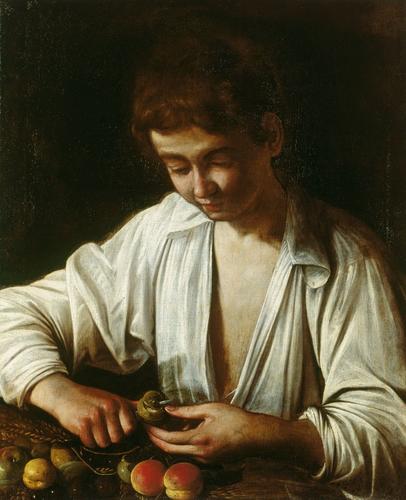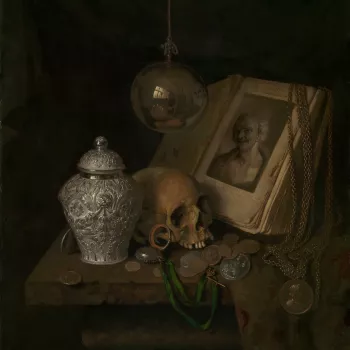Boy Peeling Fruit c.1592-3
Oil on canvas | 63.0 x 53.0 cm (support, canvas/panel/stretcher external) | RCIN 402612
-
Caravaggio was probably the most influential painter of the early seventeenth century. This may be his earliest surviving painting, dating from his first years in Rome. Here we see Caravaggio's interest in recording reality, with posed model and still life, which was to continue throughout his career.
There are a handful of references in contemporary sources to this composition, which dates from Caravaggio's early struggling years in Rome. One of the first paintings mentioned in Mancini's biography is a 'boy peeling a pear with a knife' (in later editions the fruit becomes an apple). There is also a record of an unattributed painting of a 'young boy seated at a table with an apple in his hand' confiscated in 1607 from Cavaliere d'Arpino's studio and given by Pope Paul V to his nephew, Cardinal Scipione Borghese. This painting does not appear in the 1693 inventory of the Borghese collection. A letter of the 16 August 1608 from Lorenzo Sarego in Perugia to Cardinal Scipione Borghese mentions a half-length painting of a boy peeling a peach by Caravaggio, which had turned up in the estate of the Perugian collector Cesare Crispolti. From these records it appears either that Caravaggio painted several versions of this composition or others, perhaps from within his circle, made copies or variants of them.
Today at least ten versions survive, all showing the peeling of a green Seville or Bergamot orange (rather than an apple, peach or pear), with other fruit scattered on the table - peaches, cherries and nectarines. They belong with a group of quite small paintings dated c.1593-7, all depicting half-length youths against simple backgrounds, evocatively lit, with prominent still lifes in the foreground; other examples include the Self-portrait as Bacchus and Boy with a Basket of Fruit (both Galleria Borghese, Rome) and the Boy Bitten by a Lizard (National Gallery, London and Longhi collection, Florence). Caravaggio's typically Lombard interest in recording reality as it was set in front of him, with posed model and still life, was to continue throughout his career. The awkwardness of the figure here compared with the Boy Bitten by a Lizard or Boy with a Basket of Fruit suggests that this is Caravaggio's earliest surviving painting.
Caravaggio's skill at still-life painting was particularly praised by early biographers and he reputedly said that 'good still-life painting required as much artistry as good figure painting'. Rudolf Wittkower was the first to suggest that these elements could read emblematically, an example followed by later critics. The bitter fruit has been thought to allude to the surprises in store for the inexperienced boy, the corkscrew turn of the peel like the turn of Fortune's wheel, although there is very little evidence that contemporaries read hidden meanings into paintings of this sort with such alacrity and ingenuity. The painting has also been related to the four seasons or the five senses, popular subjects among north Italian painters such as Jacapo Bassano, Vincenzo Campi and Bartolomeo Passerotti. The painting could allude to autumn, or to the sense of taste: one critic has suggested that the Boy Bitten by a Lizard and the Boy Peeling Fruit were painted as a pair, one representing touch and the other taste, which raises the question of what happened to the other three senses. It is more likely that the painting alludes to sensory experience in a more general way through its descriptive naturalism, as if saying to the viewer, 'this fruit is so lifelike that you can feel it, smell it and taste it, as well as seeing it'.
There are several fine versions of this composition with claims to be original works by Caravaggio and no reason to suppose that there must be only one such original. The versions in the Ishizuka Collection, Tokyo and Private Collection, London have both been accepted as by Caravaggio: the latter uses his characteristic brown underpainting, left visible in the shadows, and has a number of small pentiments. The way in which the broken folds of the boy's shirt in the Tokyo version are painted has been compared to the work of Cavaliere d'Arpino, which may suggest that it was executed when Caravaggio was in his studio. A version in a private collection in Rome, proposed as by Caravaggio by Marini in 1978, also has some pentiments, but its larger format, including all of the boy's arms and two additional fruits, suggests that it is an amplified repetition of the composition and certainly not the unique prototype.
There is also a strong case to be made that the Royal Collection version is an - if not the - original. The fact that it was recorded in the James II inventory as by 'Michael Angelo' (Caravaggio's Christian name) means that it was already thought to be by Caravaggio in the seventeenth century. The folds of the boy's shirt are less smooth and finished than in the other versions, having the broken liveliness of the shirt of the Boy with a Basket of Fruit. This work also shares with other early paintings by Caravaggio an undercurrent of expressive, Venetian-type brushwork, seen in the drapery and still life and missing from the other versions. There is a grey ground characteristic of Caravaggio at this date. There are a number of pentiments: pink flesh shows through the white of the boy's right sleeve, which was originally more rolled up, an alteration that a copyist would not need to make; the outline of his right shoulder is altered. The knife handle was painted after the two ears of corn. Flesh painting extends under the shirt on his left side. Just above the fruit there are dark shapes created by two leaves, which have been painted over with strokes of white; with age the white has become more transparent and the leaves more visible. These dark shapes have been repeated in other versions, including those in Tokyo, London and Rome, but without the leaves underneath, which suggests that they were copied unthinkingly from this one. They are there made to look like shadows cast by the thumb, fruit and knife, though the direction of light makes this impossible.
Catalogue entry adapted from The Art of Italy in the Royal Collection: Renaissance and Baroque, London, 2007Provenance
Possibly acquired by Charles II; first recorded in the King's Great Closet at Whitehall Palace in 1688 (no 538) 'By Michael Angelo - A piece, being a boy in his shirt, paring fruit'
-
Creator(s)
-
Medium and techniques
Oil on canvas
Measurements
63.0 x 53.0 cm (support, canvas/panel/stretcher external)
74.6 x 61.4 cm (frame, external)
Category
Object type(s)
Other number(s)
Alternative title(s)
Boy paring fruit










